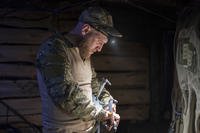Lt. Col. Morris “Moose” Fontenot, Jr., took off in a 28-year-old F-15C Eagle fighter from Barnes Air National Guard Base near Boston on a Aug. 27 flight to New Orleans, where the aircraft was to receive a radar upgrade to extend its life cycle.
Shortly before 9 a.m., Fontenot, who had 17 years experience in F-15s, reported an in-flight emergency while flying above 30,000 feet over Virginia. At 9 a.m., the Washington Center Air Traffic Control lost contact with the aircraft.
Col. James Keefe, Fontenot’s commander at the 104the Fighter Wing based at Barnes, said he learned at about 9:30 a.m. that the aircraft had crashed in a remote area near Deerfield Valley, Va. It took search teams two days to find the crash site and Fontenot’s remains.
“This tragedy hit the wing very hard,” Keefe said.
Fontenot, an Air Force Academy graduate, was the 104th’s Inspector General in charge of implementation of the Air Force Inspection System. He was also an F-15 instructor pilot with more than 2,300 flight hours.
The cause of the accident was under investigation, but the crash underlined concerns expressed for years by top Air Force officials about metal fatigue, structural issues and maintenance for its fleet of aging fighters, bombers and tankers.
At the 104th Fighter Wing, Master Sgt. Robert Sabonis said Tuesday that the Wing currently has 18 F-15s assigned to it, most of them F-15Cs. “Right now, we’re focused on upgrading the existing aircraft,” Sabonis said. There was no word on when the Wing might “swap out” for newer models, Sabonis said.
Last year at the Air Force Association’s Air and Space Conference, Gen. Janet Wolfenbarger, commander of the Air Force Materiel Command, made the aging fleet the topic of her address.
“We are very good at maintaining legacy aircraft,” Wolfenbarger said. “We, along with our industry partners, can continue to maintain these systems for the length of time our nation demands. But, I have to tell you, they are not necessarily up to the threats that are evolving.” Wolfenbarger was to be a featured speaker again this year at the AFA’s Air and Space Conference at National Harbor, Md., beginning Monday.
Earlier this summer, Air Force Secretary Deborah Lee James said that the aging aircraft fleet was a factor in a drop in Air Force readiness.
“The point is you’ve got to be ready,” James told the Defense Writers Group in June. “Our readiness in the Air Force, as a total force over the years, has atrophied -- that is to say the full spectrum of our readiness,” James said.
For more than a decade, the readiness of the F-15s has been a major concern of the Air Force. In November 2007, those concerns came to a head when a Missouri Air National Guard F-15C broke apart over Boss, Missouri. The pilot safely ejected.
The incident forced the grounding of the entire F-15 fleet during the accident investigation. Air Force Lt. Gen. Gary L. North, then the commander of the U.S. Central Command’s Combined Forces Air Component, put all of his F-15Es on ground alert while flying missions in Iraq and Afghanistan with other aircraft.
"I worry about the health of our aging fleet and how sometimes it is not well understood by those our airmen protect," North said at the time.
There were two separate issues with the F-15s, said Loren Thompson, head of the Lexington Institute and a Pentagon consultant.
“First, there are problems with corrosion, metal fatigue and parts obsolescence,” Thompson said. The second issue was that “the Air Force hasn’t significantly modernized the fleet since the Cold War,” Thompson said.
“The bottom line is that this entire fleet is becoming decrepit because nobody has modernized it,” Thompson said. “We just never get around to buying new planes.”








